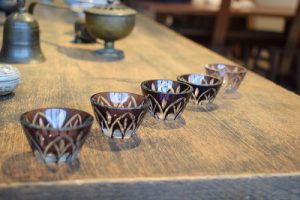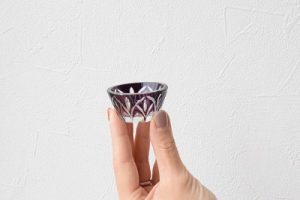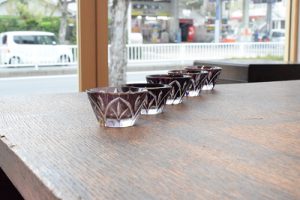江戸切子と薩摩切子(愛知県名古屋市千種区姫池通 骨董買取いたします 古美術風光舎名古屋店)
2022.04.02
皆さまこんにちは
スタッフNでございます。
昨日、きまぐれに映画館で映画のチケットを購入したら、ロッカーに手荷物を預けられ、不思議に思っていると、まさかのMX4Dでした。
MX4Dとは、風や水しぶきが出たり椅子が揺れたりするアトラクション型シアターなのですが、楽しかったです。
飲み物やポップコーンを買わなくてよかったです。

さて、先日買取させていただいた中にとても可愛らしいグラスがございました。
この切子細工のグラス、手のひらサイズで持ちやすく色も上品な紫色で美しいです。
模様もシンプルでいいですよね。
5つ並んでいる姿も素敵です。
店主もお気に入りで「可愛い~!可愛い!」と連呼しておりました。

日本の切子は、江戸切子と薩摩切子の2つが有名でございます。
江戸切子は、庶民が日常的に使う物として商人が作り出しました。
色被せガラスが薄く、透明感や華やかさが特徴的で、幕末・維新を乗り越え、受け継がれております。
一方薩摩切子は、主に海外との交易用、鑑賞用に作られており、藩レベルでの産業として発展致します。色被せガラスに厚みがあり、重厚感が特徴的で、幕末・維新に工場が焼失、藩もなくなり産業が途絶えますが、現在は復刻生産されております。
江戸切子と薩摩切子の一番の違いは、カット後の色ガラスの残り方にあります。
江戸切子は色ガラスの部分が薄く、カットした後はカットした透明な部分と色つきの部分の境目がシャープになるのに対し、薩摩切子は色ガラスの部分が厚い為、カットすると境界の部分がグラデーションのようになるのです。
天保5年に江戸でビードロ問屋を営んでいた加賀屋久兵衛が、西洋から持ち込まれたガラス製品に金剛砂を使って切子細工を施したのが江戸切子の始まりと言われています。
黒船が来航した時、献上品の中に加賀屋の切子瓶があり、その細工の美しさにペリーが驚いたという話も残っています。
明治時代に入るとガラス製作が政府の事業のひとつとなり、ヨーロッパの新しい技術なども導入され、江戸時代後期から続く江戸切子の伝統は絶えることなく現代に受け継がれてきているのです。
1985年に東京都の伝統工芸品に指定、2002年に経済産業大臣指定伝統的工芸品に指定されています。
薩摩藩28代目藩主島津斉彬は諸藩に先駆けて造船、製鉄、紡績、印刷など大規模な近代化事業を推進します。
この中にガラス工場も含まれており、薩摩切子を始めとする様々なガラス製品を製造していました。
「薩摩の紅ガラス」とその美しさを称賛されたガラスの着色方法も研究され、紅・藍・紫・緑などの発色に成功したと言われています。
しかし斉彬が急逝するとこの事業も縮小され、1863年の薩英戦争で工場が焼失し、明治に入ってからの西南戦争前後には薩摩切子の技術も完全に途絶えてしまいました。
それから100年経った1985年、鹿児島市に薩摩ガラス工芸が設立され薩摩切子を復元。
その伝統を大切にしながら、新しい商品への開発にも意欲的に取り組んでいるそうです。
2001年には新世紀の始まりを記念し「二色被せ」の薩摩切子が誕生。
単色での濃淡が基本だった切子の色彩に、新しい世界が広がりました。
現在はさつま町、霧島市、南さつま市、鹿児島市にある5つの工房で薩摩切子は生産されています。

また、最近話題なのは黒色の切子。
切子はカットする際に裏側から光を当てて下書きの線を確認しながらグラインダーでカットするのですが、黒色だと光が通らない為、下書きの線は見えません。
長年の修行を積んだ職人が、カットの音や振動を頼りに、五感を駆使してようやく完成する事が出来る逸品なのです。
切子には食器、酒器、花器、ランプなどの商品があります。
中でもグラス類が最も多く、ぐい呑み、焼酎グラス、ロックグラス、ワイングラス、タンブラー、ビアグラス、冷酒グラス、升グラス、シャンパングラス、等の酒器が人気でございます。。
贈答用や各種お祝い事の記念品などとしても喜ばれております。
食器では小皿~大皿、小鉢、大鉢、サラダボウル、またペーパーウエイトやスマホケースといった小物や、置時計やフォトフレーム、風鈴、アクセサリーなどといった商品もあります。
切子はとても繊細なので、その取扱い方にも注意が必要です。
特にグラスや食器など、頻繁に出番がある物のお手入れの方法は、
- 柔らかいスポンジや布などを使って洗う
- 食洗機は使用しない
- 急な温度変化に弱いので熱いものはもちろん、冷蔵庫に入れるのもNG
- ほかの食器との接触で割れやすいので気を付ける。重ねるのは厳禁
- 油汚れのものと一緒に洗わない
- 拭く時も柔らかい布で丁寧に優しく行なう
などのことに気を付けましょう。
それでもある程度使っていると「くすみ」が生じてきます。
その場合は家庭用の漂白剤を薄めて浸すこと数分で、くすみが取れて切子の輝きが復活するそうです。
江戸切子を実際に体験できる工房などもございます。
世界にひとつだけの自分オリジナルの切子細工、是非つくってみたいものですね。
繊細さと艶やかさを合わせ持つ日本の切子は、国内だけではなく、海外での人気も根強いものがございます。
江戸時代からの人々の願いが込められた切子細工、これまでの伝統技術を大切に受け継ぎ、新しいものも取り入れながら進歩していく文化は大切にしていきたいですね。
母の日に、切子細工グラスにカーネーションを添えてプレゼントなんていうのも嬉しいですね。
ではでは

Hello everyone
This is Staff N.
Yesterday, when I bought a movie ticket at a movie theater on a whim, I left my baggage in a locker, and when I was wondering, it was MX4D.
MX4D is an attraction-type theater where the wind, splashes, and chairs sway, but it was fun.
I didn’t have to buy drinks or popcorn.
By the way, there was a very cute glass that I bought the other day.
This cut glass is palm-sized and easy to hold, and the color is elegant purple and beautiful.
The pattern is simple, isn’t it?
The appearance of five lines is also wonderful.
The president also liked it and called it “Cute! Cute!”
There are two famous Japanese kiriko, Edo kiriko and Satsuma kiriko.
Edo Kiriko was created by merchants as something that ordinary people use on a daily basis.
The colored glass is thin, and it is characterized by its transparency and gorgeousness, and has been passed down through the end of the Edo period and the Meiji Restoration.
On the other hand, Satsuma Kiriko is mainly made for foreign trade and appreciation, and will develop as an industry at the clan level. The colored glass is thick and has a profound feeling. At the end of the Edo period and the Meiji Restoration, the factory was burned down, the clan disappeared, and the industry was cut off, but it is currently being reprinted.
The biggest difference between Edo Kiriko and Satsuma Kiriko is the way the colored glass remains after cutting.
Edo Kiriko has a thin colored glass part, and after cutting, the boundary between the cut transparent part and the colored part becomes sharp, while Satsuma Kiriko has a thick colored glass part, so when you cut it, the boundary part becomes sharp. It looks like a gradation.
It is said that Edo Kiriko began when Kyubei Kagaya, who ran a beadro wholesaler in Edo in the 5th year of Tenpo, used Kongo sand to cut glass products brought in from the West.
When Kurofune arrived, there was a Kagaya Kiriko bottle in the gift, and there is a story that Perry was surprised at the beauty of the work.
In the Meiji era, glass production became one of the government’s businesses, new European technologies were introduced, and the tradition of Edo Kiriko, which has continued since the latter half of the Edo period, has been continuously passed down to the present day.
It was designated as a traditional craft of Tokyo in 1985, and designated as a traditional craft by the Minister of Economy, Trade and Industry in 2002.
Shimazu Nariakira, the 28th feudal lord of the Satsuma Domain, will promote large-scale modernization projects such as shipbuilding, iron making, spinning, and printing ahead of other domains.
This included a glass factory, which manufactured various glass products such as Satsuma Kiriko.
Research was also conducted on “Satsuma’s red glass” and the method of coloring glass, which was praised for its beauty, and it is said that it succeeded in developing colors such as red, indigo, purple, and green.
However, when Nariakira died suddenly, this business was also reduced, the factory was burned down in the Satsuma Rebellion in 1863, and Satsuma Kiriko’s technology was completely lost before and after the Satsuma Rebellion in the Meiji era.
In 1985, 100 years later, Satsuma Glass Crafts was established in Kagoshima City and restored Satsuma Kiriko.
While valuing that tradition, he is enthusiastically working on the development of new products.
In 2001, Satsuma Kiriko was born in commemoration of the beginning of the new century.
A new world has opened up in the colors of Kiriko, which was based on shades of a single color.
Currently, Satsuma Kiriko is produced at five workshops in Satsuma Town, Kirishima City, Minamisatsuma City, and Kagoshima City.
Also, the topic recently is the black facet.
When cutting a kiriko, shine light from the back side and cut it with a grinder while checking the draft line, but if it is black, the light does not pass, so the draft line cannot be seen.
It is a gem that a craftsman who has trained for many years can finally complete by making full use of his five senses, relying on the sound and vibration of the cut.
Kiriko has products such as tableware, sake sets, vases, and lamps.
Among them, glasses are the most popular, and sake sets such as drinking glass, shochu glass, rock glass, wine glass, tumbler, beer glass, cold sake glass, box glass, champagne glass, etc. are popular. ..
It is also appreciated as a gift or as a souvenir for various celebrations.
As for tableware, there are small plates to large plates, small bowls, large bowls, salad bowls, small items such as paper weights and smartphone cases, and products such as table clocks, photo frames, wind chimes, and accessories.
Kiriko is very delicate, so you need to be careful about how to handle it.
Especially, how to care for things that are frequently used, such as glasses and tableware,
Wash with a soft sponge or cloth
Do not use the dishwasher
Since it is vulnerable to sudden temperature changes, it is NG to put it in the refrigerator as well as hot ones.
Be careful as it is easily broken by contact with other tableware. Do not stack
Do not wash with greasy items
Gently and gently wipe with a soft cloth.
Let’s be careful about such things.
Even so, if you use it to some extent, “dullness” will occur.
In that case, dilute and soak the household bleach in a few minutes to remove the dullness and restore the brilliance of the kiriko.
There is also a workshop where you can actually experience Edo Kiriko.
I definitely want to make my own original cutlery work, which is the only one in the world.
Japanese Kiriko, which has both delicacy and luster, is popular not only in Japan but also overseas.
I would like to cherish the culture of making progress while carefully inheriting the traditional techniques of Kiriko work, which has been filled with the wishes of people from the Edo period, and incorporating new ones.
On Mother’s Day, it’s nice to have a carnation on a cut glass as a gift.
See you soon
*********************
新年度を迎えました。
風光舎では、古美術品や骨董品の他にも絵画や宝石、趣味のお品など様々なジャンルのものを買受しております。
お片付けをされていて、こういうものでもいいのかしらと迷われているものでも、どうぞお気軽にご相談下さいませ。
また風光舎は、出張買取も強化しております。
ご近所はもちろん、愛知県内、岐阜県、三重県その他の県へも出張いたします。
まずは、お電話お待ちしております。
愛知県名古屋市千種区・骨董 買取
『古美術 風光舎 名古屋店』
TEL 052(734)8444
10:00-17:00 OPEN

